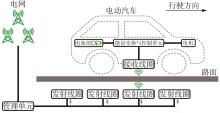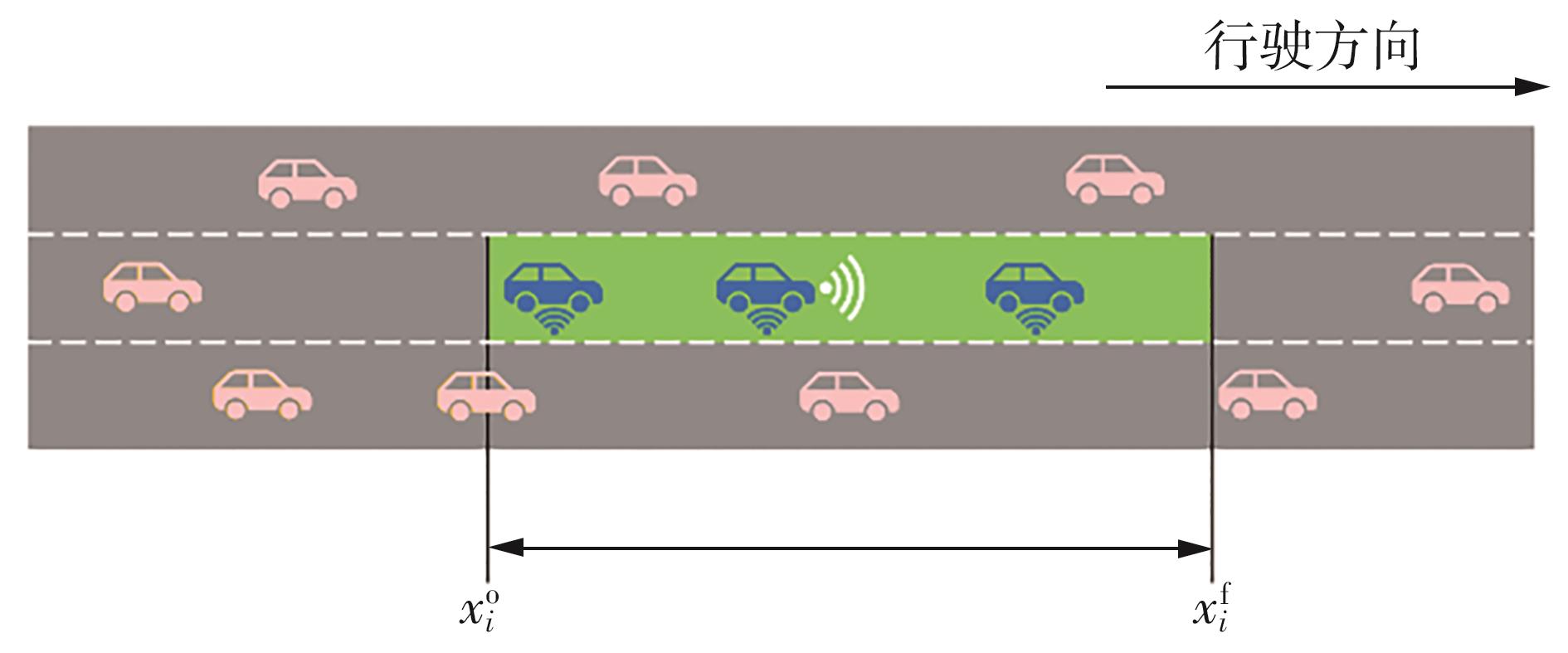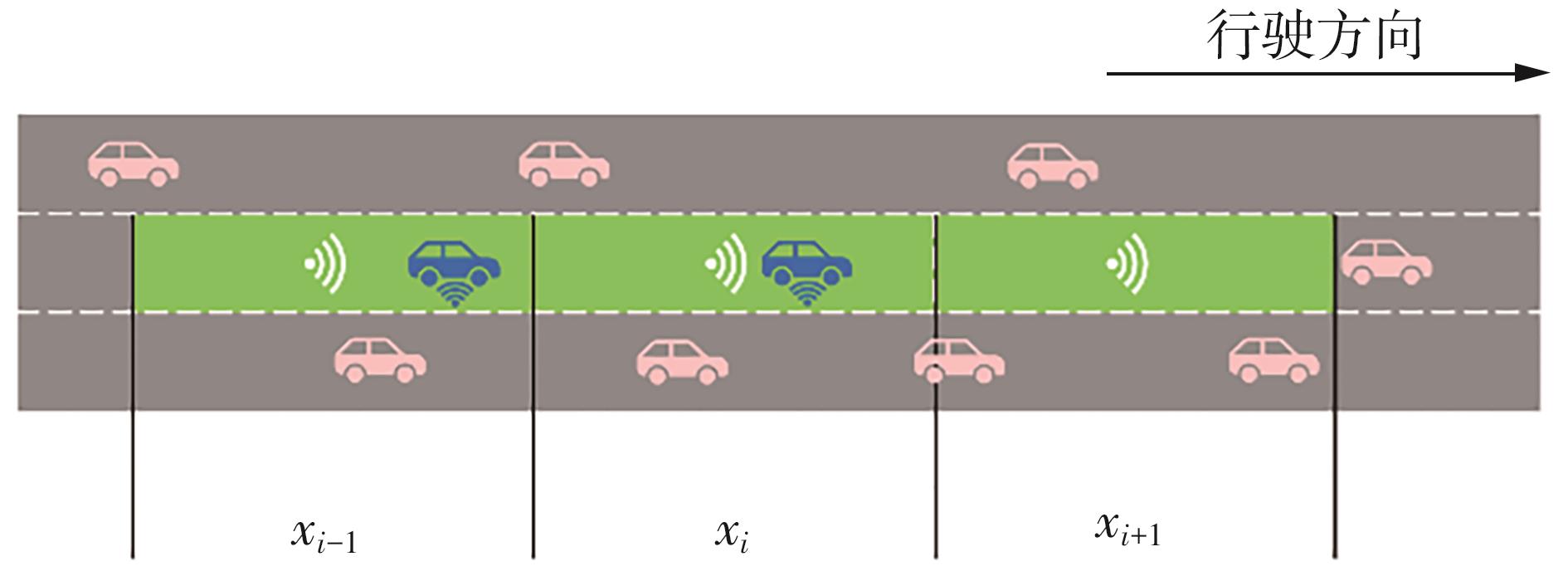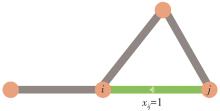Journal of South China University of Technology(Natural Science Edition) ›› 2023, Vol. 51 ›› Issue (10): 135-151.doi: 10.12141/j.issn.1000-565X.230261
Special Issue: 2023绿色智慧交通系统专辑
• Green, Intelligent Traffic System • Previous Articles Next Articles
Modeling Method for Optimizing Dynamic Wireless Charging Lane of Electric Vehicles
PEI Mingyang ZHU Hongyu
- School of Civil Engineering and Transportation,South China University of Technology,Guangzhou 510640,Guangdong,China
-
Received:2023-04-10Online:2023-10-25Published:2023-07-03 -
Contact:裴明阳(1990-),女,博士,副教授,博士生导师,主要从事交通系统优化研究。 E-mail:mingyang@scut.edu.cn -
About author:裴明阳(1990-),女,博士,副教授,博士生导师,主要从事交通系统优化研究。 -
Supported by:the Basic and Applied Research Foundation of Guangdong Province(2020A1515111024)
CLC Number:
Cite this article
PEI Mingyang, ZHU Hongyu. Modeling Method for Optimizing Dynamic Wireless Charging Lane of Electric Vehicles[J]. Journal of South China University of Technology(Natural Science Edition), 2023, 51(10): 135-151.
share this article
Table 1
Some current standards for wireless charging"
| 系列 | 标准 | 内容 |
|---|---|---|
| IEC | IEC 61980-3:2022 | 磁场无线充电系统的具体要求 |
| IEC 61980-1:2020 | 电动汽车无线充电系统的通用要求 | |
| IEC TS 61980-2:2019 | 电动汽车和基础设施之间通信协议 | |
| IEC TR 62905:2018 | WPT系统的暴露评估方法 | |
| ISO | ISO 19363:2020 | 安全和互操作性要求 |
| ISO 15118-8:2020 | 无线通信物理层和数据链路层要求 | |
| SAE | SAE J2954-202208 | 对位方法论 |
| SAE J2836/6-202104 | 无线通信实例 | |
| GB | GB/T 38775—2021 | 电磁兼容性要求和试验方法;互操作性要求及测试 |
| GB/T 38775—2020 | 通用要求;通信协议;特殊要求;电磁环境限值与测试方法 |
| 1 | BOULANGER A G, CHU A C, MAXX S,et al .Vehicle electrification:status and issues[J].Proceedings of the IEEE,2011,99(6):1116-1138. |
| 2 | 严军华,王舒笑,袁浩然,等 .电动汽车能耗与气体排放分析及环境影响评价[J].华南理工大学学报(自然科学版),2018,46(6):137-144. |
| YAN Jun-hua, WANG Shu-xiao, YUAN Hao-ran,et al .Life cycle assessment of energy consumption with emission and environmental impact of electric vehicle [J].Journal of South China University of Technology(Natural Science Edition),2018,46(6):137-144. | |
| 3 | 中国政府网 .国务院关于印发节能与新能源汽车产业发展规划(2012―2020年)的通知[EB/OL].(2012-06-28)[2023-03-10].. |
| 4 | 中国政府网 .国务院办公厅关于印发新能源汽车产业发展规划(2021—2035年)的通知[EB/OL].(2020-11-02)[2023-03-10].. |
| 5 | IEA. Global Electric Vehicle Outlook 2022[EB/OL].(2022-05-23)[2023-03-10].. |
| 6 | 国家能源局 .中国充电联盟联合能链智电发布《2022中国电动汽车用户充电行为白皮书》[EB/OL].(2023-03-20)[2023-03-22].. |
| 7 | 谢驰,白婷,王同根 .里程焦虑下的电动汽车交通网络均衡[J].中国科技论文,2017,12(19):2161-2165. |
| XIE Chi, BAI Ting, WANG Tong-gen .Traffic network equilibrium for electric vehicles with range anxiety[J].China Sciencepaper,2017,12(19):2161-2165. | |
| 8 | 田梦瑶,汤波,杨秀,等 .综合考虑充电需求和配电网接纳能力的电动汽车充电站规划[J].电网技术,2021,45(2):498-509. |
| TIAN Meng-yao, TANG Bo, YANG Xiu,et al .Planning of electric vehicle charging stations considering charging demands and acceptance capacity of distribution network[J].Power System Technology,2021,45(2):498-509. | |
| 9 | LU F, ZHANG H, HOFMANN H,et al .A dynamic charging system with reduced output power pulsation for electric vehicles[J].IEEE Transactions on Industrial Electronics,2016,63(10):6580-6590. |
| 10 | 马涛,裴耀文,陈丰,等 .感应充电路面技术研究现状与展望[J].中国公路学报,2022,35(7):36-54. |
| MA Tao, PEI Yao-wen, CHEN Feng,et al .A state-of-the-art review on IPT-based electrified road technology[J].China Journal of Highway and Transport,2022,35(7):36-54. | |
| 11 | 胡泽春,宋永华,徐智威,等 .电动汽车接入电网的影响与利用[J].中国电机工程学报,2012,32(4):1-10. |
| HU Ze-chun, SONG Yong-hua, XU Zhi-wei,et al .Impacts and utilization of electric vehicles integration into power systems[J].Proceedings of the CSEE,2012,32(4):1-10. | |
| 12 | MOHAMED A A S, SHAIER A A, METWALLY H,et al .An overview of dynamic inductive charging for electric vehicles[J].Energies,2022,15(15):5613. |
| 13 | 范兴明,莫小勇,张鑫 .无线电能传输技术的研究现状与应用[J].中国电机工程学报,2015,35(10):2584-2600. |
| FAN Xing-ming, MO Xiao-yong, ZHANG Xin .Research status and application of wireless power transmission technology[J].Proceedings of the CSEE,2015,35(10):2584-2600. | |
| 14 | TAN Z, LIU F, CHAN H K,et al .Transportation systems management considering dynamic wireless charging electric vehicles:review and prospects[J].Transportation Research Part E:Logistics and Transportation Review,2022,163:102761. |
| 15 | JEONG S, JANG Y J,KUM D. Economic analysis of the dynamic charging electric vehicle[J].IEEE Trans Power Electron,2015,30(11):6368-6377. |
| 16 | BOLGER J G, KIRSTEN F A, NG L S .Inductive power coupling for an electric highway system[C]∥Proceedings of the 28th IEEE Vehicular Technology Conference.Denver:IEEE,1978:137-144. |
| 17 | COVIC G A, BOYS J T .Modern Trends in inductive power transfer for transportation applications[J].IEEE Journal of Emerging and Selected Topics in Power Electronics,2013,1(1):28-41. |
| 18 | CHEN L, NAGENDRA G R, BOYS J T,et al .Double-coupled systems for IPT roadway applications [J].IEEE Journal of Emerging and Selected Topics in Power Electronics,2015,3(1):37-49. |
| 19 | CHEN F, TAYLOR N, KRINGOS N .Electrification of roads:opportunities and challenges[J].Applied Energy,2015,150:109-119. |
| 20 | ONAR O C, MILLER J M, CAMPBELL S L,et al .A novel wireless power transfer for in-motion EV/PHEV charging[C]∥Proceedings of the 28th Annual IEEE Applied Power Electronics Conference and Exposition (APEC).CA:IEEE,2013:3073-3080. |
| 21 | KO Y D, JANG Y J .The optimal system design of the online electric vehicle utilizing wireless power transmission technology[J].IEEE Transactions on Intelligent Transportation Systems,2013,14(3):1255-1265. |
| 22 | AMDITIS A, THEODOROPOULOS T, BRUSAGLINO G,et al .Energy management optimization within the electric mobility system[C]∥Proceedings of the 6th International Conference on Clean Electrical Power (ICCEP).Santa Margherita Ligure:IEEE,2017:110-116. |
| 23 | BRECHER A, ARTHUR D .Review and evaluation of wireless power transfer (WPT) for electric transit applications[J].Human Factors the Journal of the Human Factors & Ergonomics Society,2014,49(5):832-841. |
| 24 | KOBAYASHI D, IMURA T, HORI Y .Real-time coupling coefficient estimation and maximum efficiency control on dynamic wireless power transfer for electric vehicles[C]∥Proceedings of the 2015 IEEE PELS Workshop on Emerging Technologies:Wireless Power.Daejeon:IEEE,2015:1-6. |
| 25 | KIM J H, LEE B S, LEE J H,et al .Development of 1-MW inductive power transfer system for a high-speed train[J].IEEE Transactions on Industrial Electronics,2015,62(10):6242-6250. |
| 26 | FENG T, SUN Y, ZUO Z,et al .Magnetic field analysis and excitation currents optimization for an omnidirectional WPT system based on three-phase tubular coils[J].IEEE Transactions on Industry Applications,2022,58(1):1268-1278. |
| 27 | 祝文姬,孙跃,高立克 .电动汽车多导轨无线供电方法[J].电力系统自动化,2016,40(18):97-101. |
| ZHU Wen-ji, SUN Yue, GAO Li-ke .Wireless power supply method for multi-rail-based electric vehicles [J].Automation of Electric Power Systems,2016,40(18):97-101. | |
| 28 | 中国电力报 .电动汽车福音丨国内首条百米级移动无线充电实验路段投运.[EB/OL].(2018-08-10)[2023-3-10].. |
| 29 | 国网江苏省电力有限公司,东南大学 .“三合一”电子公路技术及应用[M].南京:东南大学出版社,2020. |
| 30 | 赵争鸣,刘方,陈凯楠 .电动汽车无线充电技术研究综述[J].电工技术学报,2016,31(20):30-40. |
| ZHAO Zheng-ming, LIU Fang, CHEN Kai-nan .New progress of wireless charging technology for electric vehicles[J].Transactions of China Electrotechnical Society,2016,31(20):30-40. | |
| 31 | 林宁,姚缨英 .恒压输出的无线电能传输系统设计[J].电力电子技术,2011,45(2):66-68. |
| LIN Ning, YAO Ying-ying .Design of a wireless energy transfer system with constant ouput[J].Power Electronics,2011,45(2):66-68. | |
| 32 | 李冲,周坤卓,石章海 .一种双拾取动态无线电能传输系统控制方法研究[J].电力系统保护与控制,2020,48(21):149-156. |
| LI Chong, ZHOU Kun-zhuo, SHI Zhang-hai .Research on a control method based on double pick-up in a DWPT system[J].Power System Protection and Control,2020,48(21):149-156. | |
| 33 | 傅文珍,张波,丘东元,等 .自谐振线圈耦合式电能无线传输的最大效率分析与设计[J].中国电机工程学报,2009,29(18):21-26. |
| FU Wen-zhen, ZHANG Bo, QIU Dong-yuan,et al .Maximum efficiency analysis and design of self-resonance coupling coils for wireless power transmission system[J].Proceedings of the CSEE,2009,29(18):21-26. | |
| 34 | 苑朝阳,张献,杨庆新,等 .无线供电高铁列车非对称耦合机构[J].电工技术学报,2017,32(18):18-25. |
| YUAN Zhao-yang, ZHANG Xian, YANG Qing-xin,et al .Asymmetric coupling mechanism of wireless power transmission system for high-speed train[J].Transactions of China Electrotechnical Society,2017,32(18):18-25. | |
| 35 | 朱庆伟,陈德清,王丽芳,等 .电动汽车无线充电系统磁场仿真与屏蔽技术研究[J].电工技术学报,2015,30(S1):143-147. |
| ZHU Qing-wei, CHEN De-qing, WANG Li-fang,et al .Study on the magnetic field and shielding technique for an electric vehicle oriented wireless charging system[J].Transactions of China Electrotechnical Society,2015,30(S1):143-147. | |
| 36 | 刘建荣,郝小妮 .考虑出行者异质性的绿色出行行为研究[J].华南理工大学学报(自然科学版),2019,47(7):99-104. |
| LIU Jianrong, HAO Xiaoni .Incorporation the heterogeneity into travelers' green tranveling choice model [J].Journal of South China University of Technology(Natural Science Edition),2019,47(7):99-104. | |
| 37 | YILMAZ M, KREIN P T .Review of battery charger topologies,charging power levels,and infrastructure for plug-in electric and hybrid vehicles[J].IEEE Transactions on Power Electronics,2013,28(5):2151-2169. |
| 38 | 于东民,杨超,蒋林洳,等 .电动汽车充电安全防护研究综述[J].中国电机工程学报,2022,42(6):2145-2164. |
| YU Dong-min, YANG Chao, JIANG Lin-ru,et al .Review on safety protection of electric vehicle charging [J].Proceedings of the CSEE,2022,42(6):2145-2164. | |
| 39 | FLEISCHHAMMER M, WALDMANN T, BISLE G,et al .Interaction of cyclic ageing at high-rate and low temperatures and safety in lithium-ion batteries[J].Journal of Power Sources,2015,274:432-439. |
| 40 | FULLER M .Wireless charging in California:range,recharge,and vehicle electrification[J].Transportation Research Part C:Emerging Technologies,2016,67:343-356. |
| 41 | CERAVOLO R, MIRAGLIA G, SURACE C,et al .A computational methodology for assessing the time-dependent structural performance of electric road infrastructures[J].Computer-Aided Civil and Infrastructure Engineering,2016,31(9):701-716. |
| 42 | CHEN Z, LIU W, YIN Y .Deployment of stationary and dynamic charging infrastructure for electric vehicles along traffic corridors[J].Transportation Research Part C:Emerging Technologies,2017,77:185-206. |
| 43 | 黄学良,王维,谭林林 .磁耦合谐振式无线电能传输技术研究动态与应用展望[J].电力系统自动化,2017,41(2):2-14. |
| HUANG Xue-liang, WANG Wei, TAN Lin-lin .Technical progress and application development of magnetic coupling resonant wireless power transfer[J].Automation of Electric Power Systems,2017,41(2):2-14. | |
| 44 | 杨威,徐英雷,王晨曲,等 .无线传能机车人体电磁环境安全研究[J].电工技术学报,2022,37(11):2665-2672. |
| YANG Wei, XU Ying-lei, WANG Chen-qu,et al .An electromagnetic safety study about human body in electric locomotive wireless charging system[J].Transactions of China Electrotechnical Society,2022,37(11):2665-2672. | |
| 45 | 杜凯,朱国荣,陆江华,等 .电动汽车无线充电系统金属异物检测方法[J].浙江大学学报(工学版),2022,56(1):56-62. |
| DU Kai, ZHU Guo-rong, LU Jiang-hua,et al .Metal object detection method in wireless electric vehicle charging system[J].Journal of Zhejiang University (Engineering Science),2022,56(1):56-62. | |
| 46 | 张献,邢子瑶,薛明,等 .无线电能传输系统异物检测技术研究综述[J].电工技术学报,2022,37(4):793-807. |
| ZHANG Xian, XING Ziyao, XUE Ming,et al .Overview of foreign object detection inwireless power transfer system[J].Transactions of China Electrotechnical Society,2022,37(4):793-807. | |
| 47 | KIM J, KIM J, KONG S,et al .Coil design and shielding methods for a magnetic resonant wireless power transfer system[J].Proceedings of the IEEE,2013,101(6):1332-1342. |
| 48 | MOGHADAM M R V, ZHANG R .Multiuser wireless power transfer via magnetic resonant coupling:performance analysis,charging control,and power region characterization[J].IEEE Transactions on Signal and Information Processing over Networks,2016,2(1):72-83. |
| 49 | KAN T, NGUYEN T D, WHITE J C,et al .A new integration method for an electric vehicle wireless charging system using LCC compensation topology:analysis and design[J].IEEE Transactions on Power Electronics,2017,32(2):1638-1650. |
| 50 | HE F, YIN Y, LAWPHONGPANICH S .Network equilibrium models with battery electric vehicles[J].Transportation Research Part B:Methodological,2014,67:306-319. |
| 51 | ALWESABI Y, LIU Z, KWON S,et al .A novel integration of scheduling and dynamic wireless charging planning models of battery electric buses[J].Energy,2021,230:120806. |
| 52 | CHEN Z, HE F, YIN Y .Optimal deployment of charging lanes for electric vehicles in transportation networks[J].Transportation Research Part B:Methodological,2016,91:344-365. |
| 53 | HE J, YANG H, TANG T Q,et al .Optimal deployment of wireless charging lanes considering their adverse effect on road capacity[J].Transportation Research Part C:Emerging Technologies,2020(111):171-184. |
| 54 | LIU H, ZOU Y, CHEN Y,et al .Optimal locations and electricity prices for dynamic wireless charging links of electric vehicles for sustainable transportation [J].Transportation Research Part E:Logistics and Transportation Review,2021,152:102187. |
| 55 | WANG T G, XIE C, XIE J,et al .Path-constrained traffic assignment:a trip chain analysis under range anxiety [J].Transportation Research Part C:Emerging Technologies,2016,68:447-461. |
| 56 | XIE C, WANG T G, PU X,et al .Path-constrained traffic assignment:modeling and computing network impacts of stochastic range anxiety[J].Transportation Research Part B:Methodological,2017(103):136-157. |
| 57 | JIANG N, XIE C, WALLER S T .Path-constrained traffic assignment:model and algorithm[J].Transportation Research Record,2012,2283(1):25-33. |
| 58 | ZHENG H, HE X, LI Y,et al .Traffic equilibrium and charging facility locations for electric vehicles[J].Networks and Spatial Economics,2016,17(2):435-457. |
| 59 | WANG T, YANG B, CHEN C L,et al .Wireless Charging Lane Deployment in Urban Areas Considering Traffic Light and Regional Energy Supply-Demand Balance [C]∥Proceedings of 2019 IEEE 89th Vehicular Technology Conference (VTC2019-Spring).Kuala Lumpur:IEEE,2019:1-5. |
| 60 | THEODOROPOULOS T, AMDITIS A, BERSENEFF B,et al .Impact of dynamic EV wireless charging on the grid[C]∥Proceedings of 2014 IEEE International Electric Vehicle Conference (IEVC).Florence:IEEE,2014:1-7. |
| 61 | RAKHYMBAY A, KHAMITOV A, BAGHERI M,et al .Precise analysis on mutual inductance variation in dynamic wireless charging of electric vehicle[J].Energies,2018,11(3):624. |
| 62 | LI S, LIU Z, ZHAO H,et al .Wireless power transfer by electric field resonance and its application in dynamic charging [J].IEEE Transactions on Industrial Electronics,2016,63(10):6602-6612. |
| 63 | HE L, KONG L, GU Y,et al .Evaluating the on-demand mobile charging in wireless sensor networks [J].IEEE Transactions on Mobile Computing,2015,14(9):1861-1875. |
| 64 | HE J, HUANG H J, YANG H,et al .An electric vehicle driving behavior model in the traffic system with a wireless charging lane [J].Physica A:Statistical Mechanics and its Applications,2017,481:119-126. |
| 65 | DEFLORIO F, CASTELLO L .Dynamic charging-while-driving systems for freight delivery services with electric vehicles:traffic and energy modelling [J].Transportation Research Part C:Emerging Technologies,2017,81:342-362. |
| 66 | JIANG C P, LIU F, CHEN S,et al .Adaptive dynamic programming based optimization scheduling for wireless mobile charging[C]∥Proceedings of IEEE 15th International Conference on Control and Automation (ICCA).Scotland:IEEE,2019:1429-1434. |
| 67 | SCHWERDFEGER S, BOCK S, BOYSEN N,et al .Optimizing the electrification of roads with charge-while-drive technology[J].European Journal of Operational Research,2022,299(3):1111-1127. |
| 68 | HWANG I, JANG Y J, KO Y D,et al .System optimization for dynamic wireless charging electric vehicles operating in a multiple-route environment[J].IEEE Transactions on Intelligent Transportation Systems,2018,19(6):1709-1726. |
| 69 | MOUHRIM N, ALAOUI A E, BOUKACHOUR J .Optimal allocation of wireless power transfer system for electric vehicles in a multipath environment[C]∥Proceedings of 2016 3rd International Conference on Logistics Operations Management (GOL).Fez:IEEE,2016:1-7. |
| 70 | KO Y D, JANG Y J, LEE M S .The optimal economic design of the wireless powered intelligent transportation system using genetic algorithm considering nonlinear cost function[J].Computers & Industrial Engineering,2015,89:67-79. |
| 71 | DU J, PEI M, JIA B,et al .Optimal deployment of dynamic wireless charging lanes for electric vehicles considering the battery charging rate[J].Journal of Advanced Transportation,2022,2022:1-15. |
| 72 | LIU Z, SONG Z .Robust planning of dynamic wireless charging infrastructure for battery electric buses[J].Transportation Research Part C:Emerging Technologies,2017(83):77-103. |
| 73 | LI H, LI J, WANG K,et al .A maximum efficiency point tracking control scheme for wireless power transfer systems using magnetic resonant coupling[J].IEEE Trans Power Electron,2015,30(7):3998-4008. |
| 74 | LIU H, WANG D Z W .Locating multiple types of charging facilities for battery electric vehicles[J].Transportation Research Part B:Methodological,2017,103:30-55. |
| 75 | ZHANG X,REY D, WALLER S T .Multitype recharge facility location for electric vehicles[J].Computer-Aided Civil and Infrastructure Engineering,2018,33(11):943-65. |
| 76 | NGO H, KUMAR A, MISHRA S .Optimal positioning of dynamic wireless charging infrastructure in a road network for battery electric vehicles[J].Transportation Research Part D:Transport and Environment,2020,85:102385. |
| 77 | MUBARAK M, ÜSTER H, ABDELGHANY K,et al .Strategic network design and analysis for in-motion wireless charging of electric vehicles [J].Transportation Research Part E:Logistics and Transportation Review,2021,145:102179. |
| 78 | FERNANDEZ E, LEITNER M, LJUBIC I,et al .Arc routing with electric vehicles:dynamic charging and speed-dependent energy consumption[J].Transportation Science,2022,56(5):1111-1408. |
| 79 | BI Z, KEOLEIAN G A, LIN Z,et al .Life cycle assessment and tempo-spatial optimization of deploying dynamic wireless charging technology for electric cars [J].Transportation Research Part C:Emerging Technologies,2019,100:53-67. |
| 80 | RIEMANN R, WANG D Z W, BUSCH F .Optimal location of wireless charging facilities for electric vehicles:Flow-capturing location model with stochastic user equilibrium [J].Transportation Research Part C:Emerging Technologies,2015,58:1-12. |
| 81 | HE F, YIN Y, ZHOU J .Deploying public charging stations for electric vehicles on urban road networks [J].Transportation Research Part C:Emerging Technologies,2015,60:227-240. |
| 82 | LIU Z, SONG Z. Dynamic charging infrastructure deployment for plug-in hybrid electric trucks[J].Transportation Research Part C:Emerging Technologies,2018,95:748-772. |
| 83 | ADIL M,ALI J, TA Q T H,et al .A reliable sensor network infrastructure for electric vehicles to enable dynamic wireless charging based on machine learning technique[J].IEEE Access,2020,8:187933-187947. |
| 84 | YANG M, LIU N, ZUO L,et al .Dynamic charging scheme problem with actor-critic reinforcement learning[J].IEEE Internet of Things Journal,2021,8(1):370-380. |
| 85 | JIANG C, WANG Z, CHEN S,et al .Attention-shared multi-agent actor-critic-based deep reinforcement learning approach for mobile charging dynamic scheduling in wireless rechargeable sensor networks[J].Entropy (Basel),2022,24(7):965. |
| 86 | 罗玉涛,刘秀田,梁伟强,等 .延长锂离子电池寿命的电动汽车复合电源设计[J].华南理工大学学报(自然科学版),2016,44(3):51-59. |
| LUO Yu-tao, LIU Xiu-tian, LIANG Wei-qiang,et al .Design of hybrid power system for prolonging lifespan of lithium-ion battery applied to electric vehicles [J].Journal of South China University of Technology(Natural Science Edition),2016,44(3):51-59. | |
| 87 | 罗玉涛,谢斌,何小颤 .电动汽车锂离子电池组参数辨识与SOC估计[J].华南理工大学学报(自然科学版),2012,40(12):79-85. |
| LUO Yu-tao, XIE Bin, HE Xiao-chan .Parameter identification and SOC estimation of lithium-ion battery pack used in electric vehicles [J].Journal of South China University of Technology(Natural Science Edition),2012,40(12):79-85. | |
| 88 | RAISEMCHE A, BOUKHNIFER M, LAROUCI C,et al .Two active fault-tolerant control schemes of induction-motor drive in EV or HEV[J].IEEE Transactions on Vehicular Technology,2014,63(1):19-29. |
| 89 | DUNN B, KAMATH H, J-M TARASCON .Electrical energy storage for the grid:a battery of choices[J].Science,2011,334:928-935. |
| [1] | ShangGuan Wenbin, YUE Lian, LÜ Hui, et al. Load spectrum based fatigue test and calculation methods for battery package [J]. Journal of South China University of Technology(Natural Science Edition), 2024, 52(3): 50-56. |
| [2] | DONG Ping, WEI Shuyang, LIU Mingbo. Scheduling Strategies for Electric Vehicle Participation in Electricity Markets Under Multi-Network Collaboration [J]. Journal of South China University of Technology(Natural Science Edition), 2023, 51(12): 83-94. |
| [3] | LUO Yutao, WU Zhiqiang . Online Joint Estimation of Main States of Lithium-Ion Battery Based on DAEKF Algorithm [J]. Journal of South China University of Technology(Natural Science Edition), 2023, 51(1): 84-94. |
| [4] | LÜ Hui, ZHAO Jiawei, MAO Haikuan, et al. Analysis of the Powertrain Mount Systems of Electric Vehicles by Considering the Correlation of Probabilistic Parameters [J]. Journal of South China University of Technology(Natural Science Edition), 2022, 50(3): 65-72. |
| [5] | ZHANG Xin CUI Yuxuan XUE Qicheng. Torque Coordinated Control Strategy of PHEV Engine Starting in Motion Process [J]. Journal of South China University of Technology(Natural Science Edition), 2021, 49(8): 129-139. |
| [6] | LIU Hanwu, LEI Yulong, FU Yao, et al. Adaptive Regenerative Braking Control Strategy of Range-Extended Electric Vehicle Based on Multi-Objective Optimization [J]. Journal of South China University of Technology (Natural Science Edition), 2021, 49(7): 42-50,65. |
| [7] | GUO Lie, GE Pingshu, XU Linna, et al. Stability Control for Distributed Drive Electric Vehicle Under Steering Condition [J]. Journal of South China University of Technology (Natural Science Edition), 2020, 48(3): 100-107. |
| [8] | YANG Jinming SUN Jieshan LIU Runpeng. Passivity-Based Control of Primary-Side and Secondary-Side Rectifier Bridge in Wireless Power Transfer System for Electric Vehicle [J]. Journal of South China University of Technology(Natural Science Edition), 2020, 48(10): 11-18,47. |
| [9] | QIN Datong QIN Ling. Energy Management Strategy for a Power-split Hybrid Electric Vehicle Based on Explicit Stochastic Model Predictive Control [J]. Journal of South China University of Technology (Natural Science Edition), 2019, 47(7): 112-120. |
| [10] | YAO Mingyao ZHANG Xiaoxing QIN Datong. Real-Time Optimization of Equivalent Factor for Plug-in Hybrid Electric Vehicle [J]. Journal of South China University of Technology (Natural Science Edition), 2019, 47(11): 44-53. |
| [11] |
YAN Junhua WANG Shuxiao YUAN Haoran CHEN Yong SHAN Rui.
Life Cycle Assessment of Energy Consumption with Emission and Environmental Impact of Electric Vehicle
[J]. Journal of South China University of Technology (Natural Science Edition), 2018, 46(6): 137-144.
|
| [12] | XIONG Huiyuan HE Shan ZHA Hongshan ZHU Xionglai. Control Strategy of Driving Torque Distribution for Two-Axle Drive Electric Vehicles#br# [J]. Journal of South China University of Technology(Natural Science Edition), 2018, 46(11): 117-124. |
| [13] | QIN Datong LIU Xingyuan LUO Song. Comprehensive Performance Optimization of PHEV Considering CVT Ratio Jumping in Mode Switching Process [J]. Journal of South China University of Technology (Natural Science Edition), 2018, 46(1): 85-90,111. |
| [14] | WAN Zhen-ping WEN Wan-yu WU Bo-xi FU Yong-qing . Cooling Channel Design of Permanent Magnetic Synchronous Motor Considering Heat Exchange and Pressure Loss [J]. Journal of South China University of Technology (Natural Science Edition), 2017, 45(7): 25-32,40. |
| [15] | WU Kai-yuan WANG Jia-jia YIN Tong ZHANG Tao. Power Supply System for LLC Resonant Charging of Electric Vehicles [J]. Journal of South China University of Technology (Natural Science Edition), 2017, 45(4): 51-58. |
| Viewed | ||||||
|
Full text |
|
|||||
|
Abstract |
|
|||||









